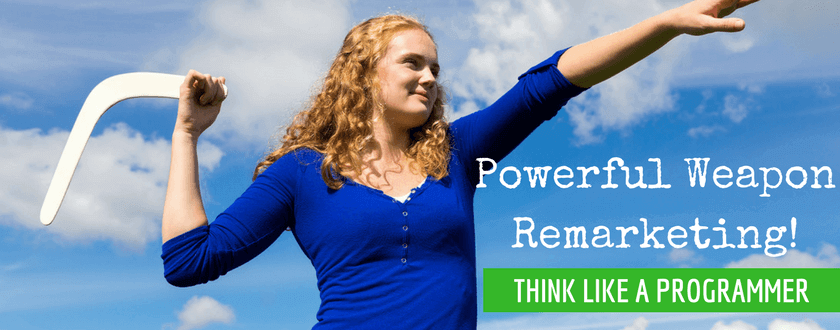One of the most powerful tools you can use in your arsenal is remarketing!
Firstly, an interesting stat for you, we’ve found that for online businesses, only 20% have remarketing in place.
What is remarketing exactly? If you think back to say five or six years ago, and someone turned up to your website and they didn’t leave their info or they didn’t make a purchase, then you had no way of marketing to them again right? So remarketing is talking about how do we put a little piece of invisible code from your website into their browser. Then you’re starting to build a list of these people. You don’t necessarily know who they are, but you can then market to them again. You can show ads to them wherever they go around the web, whether it’s on Facebook or on to the Google Display Network, basically wherever they go. It’s an amazing tool!
We like to refer to this as filling the holes in the bucket, because what we do know is that for every 100 people that hit your site, 95% of them or more are leaving without converting. So what that means is you’ve spent a dollar to get each one of them there, 100 bucks, you’ve thrown away $95 and you kept $5. So the real opportunity is how do we really advertise to those other 95 that have left. We call this the 95% rule, but it’s probably closer to 99% for most businesses.
This is the most common remarketing that we see:
Someone hits your website >>> you’ve got that little piece of code from Google or Facebook >>> you’ve got it added to your website >>> people then hit your website and leave without purchasing or without a conversion >>> then they get added to your remarketing list >>> then you can start to show them ads again.
If this is all you’re doing, it’s still brilliant. As I mentioned above, it’s better than most businesses. But, we wanna take you from good to great.
Now it’s time to add video into the mix. Video, especially on Facebook, is the most powerful way of putting content out into the marketplace. The reason why is because it’s jut so, so cost-effective, it costs two or three cents per video view, so you can put your video content out to thousands and thousands of people for just a couple hundred bucks. Video posts are always going to do better than image posts, which are always gonna do better than just normal text posts without an image.
Something pretty cool that a lot of people don’t realize is when people watch your video, Facebook is automatically adding them to a list for you, a remarketing list. Google is already adding them to a remarketing list as well. So what this means is, if someone’s watched a couple of seconds of your video or they might have watched 50% of it or they might have watched 75% of it, you can now start showing ads to those people as well, and the best part is they haven’t even hit your website yet. So you put out some awesome awareness content, they watch that. Then over time, you might wanna treat people differently, for example depending on how much of that video content they watched might give you a better idea of how “qualified they are / how interested they are in your offer/product.
Video content with Helpful Content does really well. But what’s probably even better is when you can demonstrate / show the product benefit. Where you can turn it into humor or entertain them is even better. Aim to have your video length in between 30 seconds and 6 minutes however there is no right or wrong answer for how long the video is, so test the lengths for your brand/product and you’ll soon know which lengths work best for you. Next steps: they’ve watched your video, now you can start showing ads to them as well.
So far we’ve gone from not being able to remarket to them at all, to then being able to cookie them and show our ads to them if they hit our website. Now we don’t even need them to hit our website for us to remarket to them, they just have to watch 3+ seconds of our videos and we can remarket our image ads, presell articles and more.
Let’s now go to an advanced level where we turn all of this into a sales funnel. Remember, a sales funnel is taking them from a completely cold prospect that has never heard of us before, they’ve got no awareness about us, right through to they’re aware, they came, they know what our benefits are, they know what our product solves, and then they want it and they ultimately buy it.
So let’s look at how we do remarketing in your sales funnel, because definitely one size doesn’t fit all as it depends on how a prospect consumes your content.
This is from AMA Medical Products:
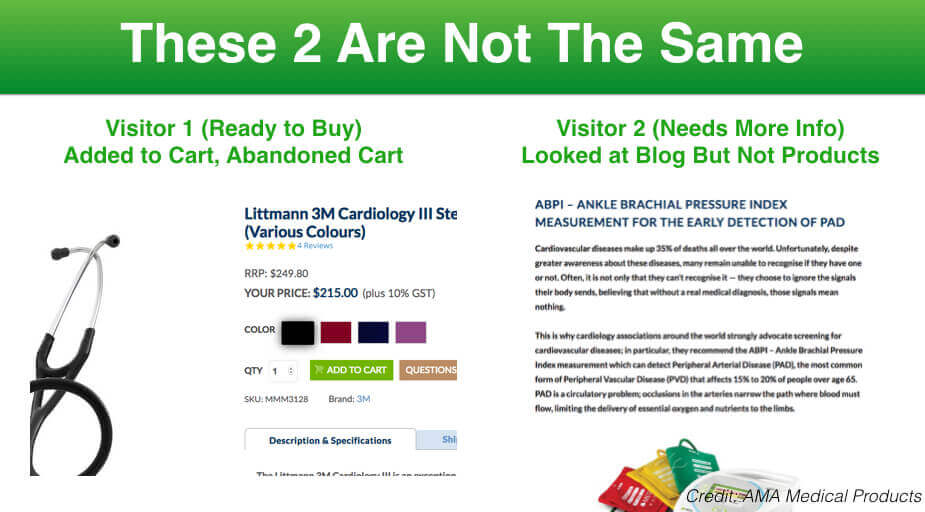
Here we have two examples where one is:
- they’ve hit the cart or hit the product page > they’ve added it to the cart > then they’ve abandoned the cart
OR - they’ve hit the blog page > they haven’t yet looked at your products
Now, the first prospect might need incentives to get them over the line. They might need a discount voucher, or something to that effect. Showing a video that shows the ownership benefits can also work well here.
But the second prospect may not even know about the range yet. So here we would show completely different marketing messages to the prospects who hit your blog page.
We need to think like a programmer:
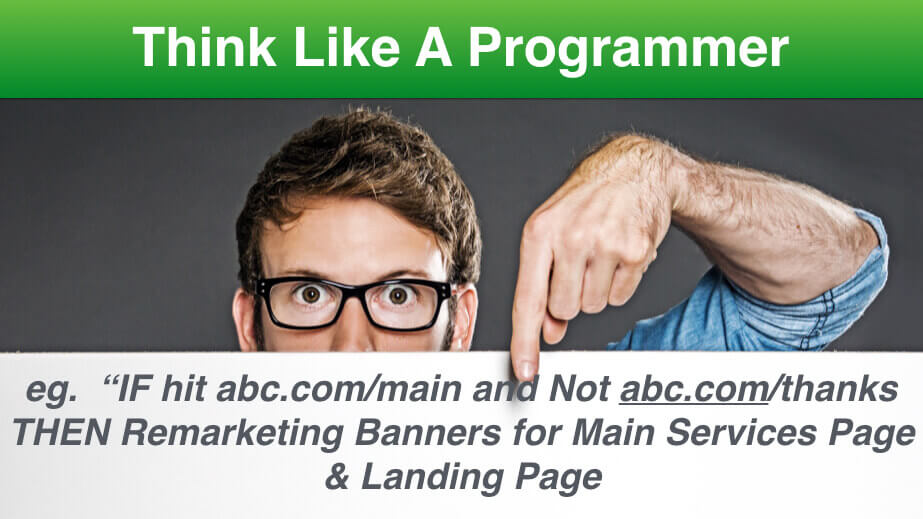
Here’s an example where if they hit abc.com/main (so if they hit our main product page) but din’t hit abc.com/thanks then they didn’t take the course of action we wanted them to take there (didn’t inquire or didn’t buy) we’re now going to show them remarketing banners for the main services page or a landing page to get them back and on your list because they’ve taken the main course of action, enquired or purchased.
Here’s a real-life example I’ve been working on with a Collective Member, Marcus:
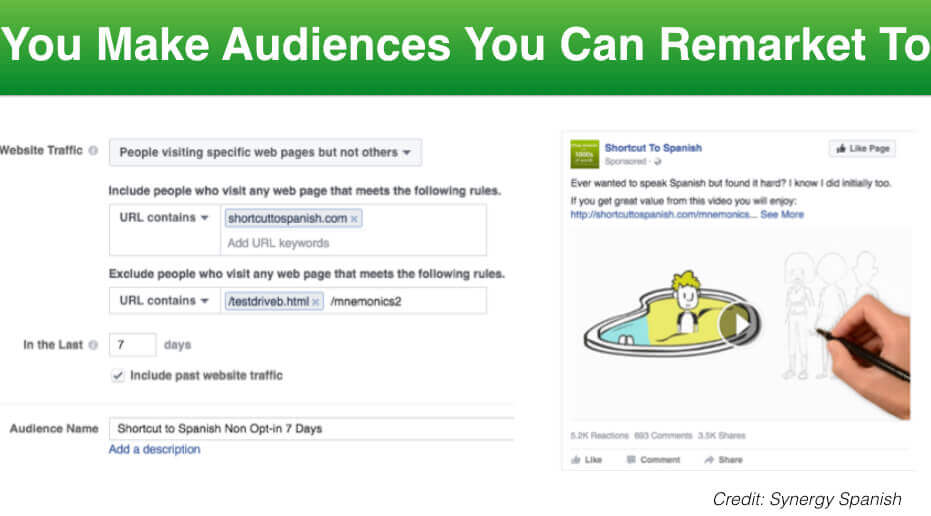
Here we have it set that if they hit a main page, but they didn’t hit a thank you page and they did this in the last seven days, then let’s show this audience segment an ad. And so in this case Marcus is using explainer videos and he’s explaining in a fun, easy way so that they’d get the concept. Then there’s a link off to where they’re more likely to convert. The best part about remarketing is that Marcus now knows what actions they’ve taken and more importantly haven’t taken and he can connect with them again with more helpful content, amazing video content and aim to alleviate any doubts. So far it’s converting very very well!
So then you start to build out a whole complex matrix of “if this, then that.” Basically the more you do, the better you go.
Here’s another logical example:
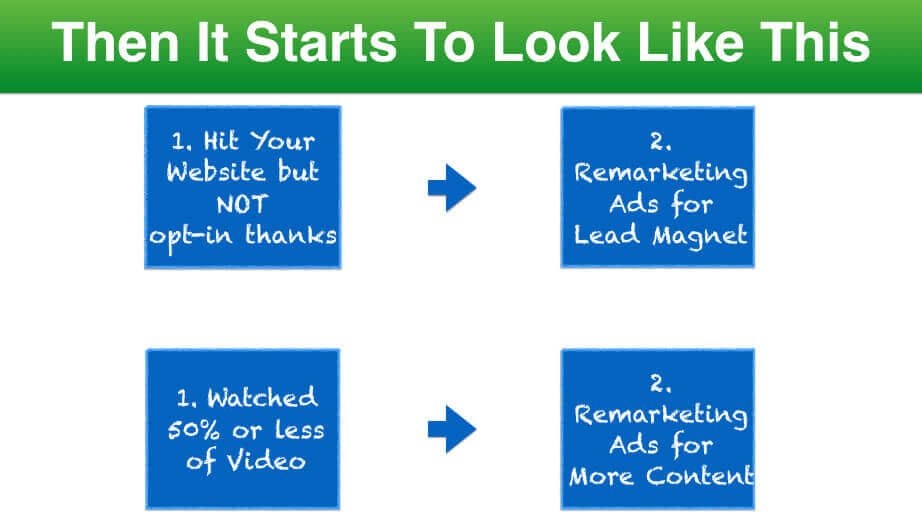
They hit your website, but they didn’t hit the opt-in thanks. Then we might remarket them ads for lead magnets. A lead magnet is basically talking about what’s something we can give them of high perceived value to get them on our database. So it might be like an e-book or a video series or swipe file or a guide, that kind of thing.
Then the next example. What about if they watch 50% or less of your main video or your videos? Then you could remarket more videos to them and show them more content. With the people haven’t seen much of my videos, I show them more videos because that one may not have interested them, but this one might – that kind of thing. That’s why something I get people telling me, “Oh, I see you everywherer” It’s not that I’m advertising everywhere. It’s that once I’ve had one touch with them, I’m remarketing to them all the time, then they do start to see me everywhere 🙂
Other examples include: they’ve watched over 50% , 75% and 95% of the video then you might wanna start showing them some more aggressive ads for the actual product or service you’re offering. Then, if they hit the main service page but not the thanks, then you want to show them a remarketing ad for the services or a video series on the services. Does that make sense? So we’re getting really, really granular. It’s also important to note that someone who watched 5% your video is not likely to be as interested as someone who watched 90% of it.
Sometimes we actually need to create what we call conversion assets to move prospects through the sales funnel journey into a customer:
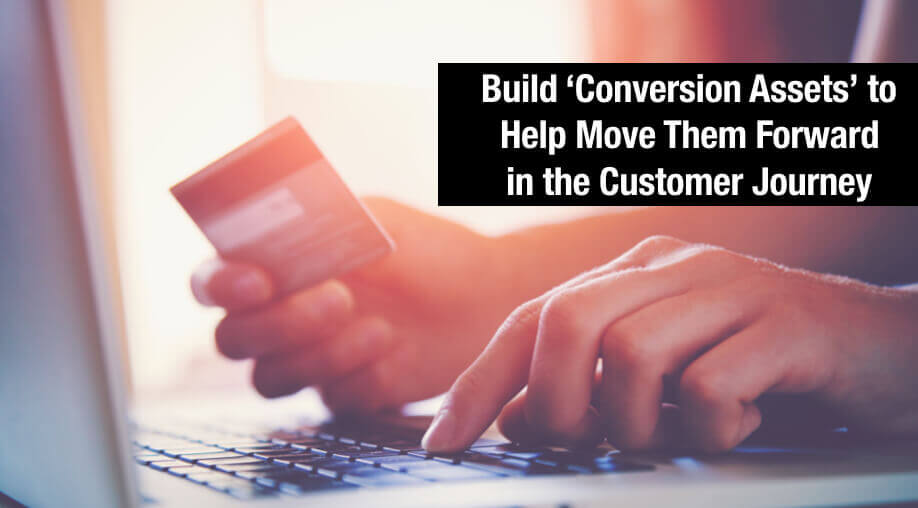
Conversion assets is any kind of information or helpful marketing, helpful content, videos, really whatever that takes people further down the journey to a customer.
In this example here they’re selling a snake repeller product:
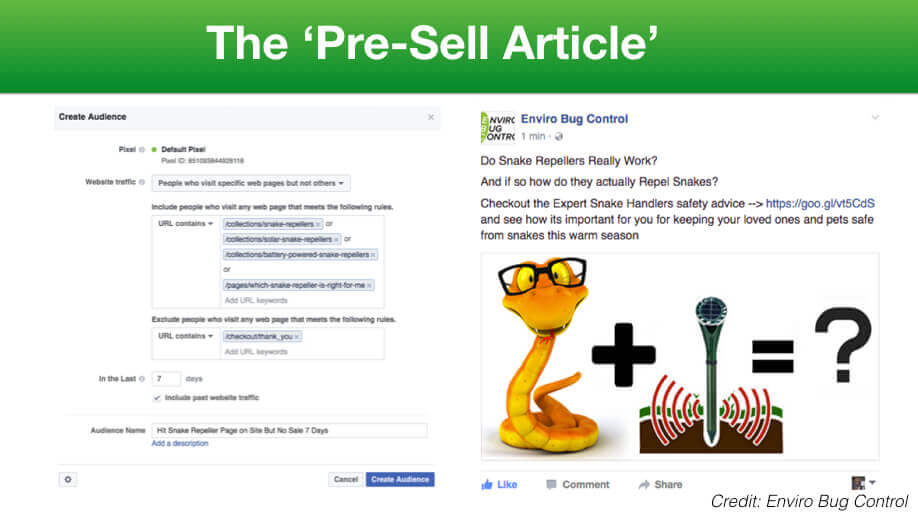
So if they hit the snake repeller product, but they didn’t get to the checkout thank you page and they did that in the last seven days, then we’re overcoming that objection here of, maybe they might just not know enough about snake repellers. So they were asking, “Hey, do the snake repellers really work?” Here you can see the visuals they’ve got there, like a snake and a snake repeller and the question mark of “does that really work?”
So then as I mentioned, to combat the doubt, they now send them over to a carefully crafted pre-sell article that basically answers the questions. And it’s just very, very helpful in general. It’s broken up into subheads, starts off helpful and answers the question that you’ve asked in that ad. Then as you get further down, you start to have links off to “use this tool to figure out how many snake repellers you need” or “watch this to see the difference between a quality snake repeller and the not so quality repeller,” that kind of thing. See an example here:
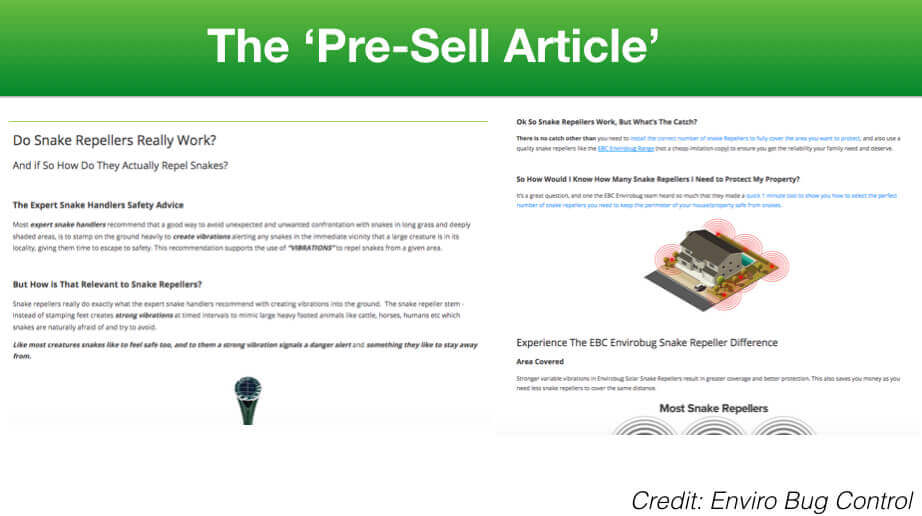
To reiterate my point here > they didn’t take the action you wanted them to take > you’re then giving them really, really helpful content in the form of a pre-sell article. You’re delivering on your promise and as they get further into down the article you can then start to have links off to your buying process again. This just works amazing.
My coach, Ezra Firestone exploded his e-commerce store BOOM by Cindy Joseph from 8 million to 22 million in the last year based off this pre-sell article content concept. Their market is great because they’re able to easily target women over 40.
So here’s an example of the pre-sell:
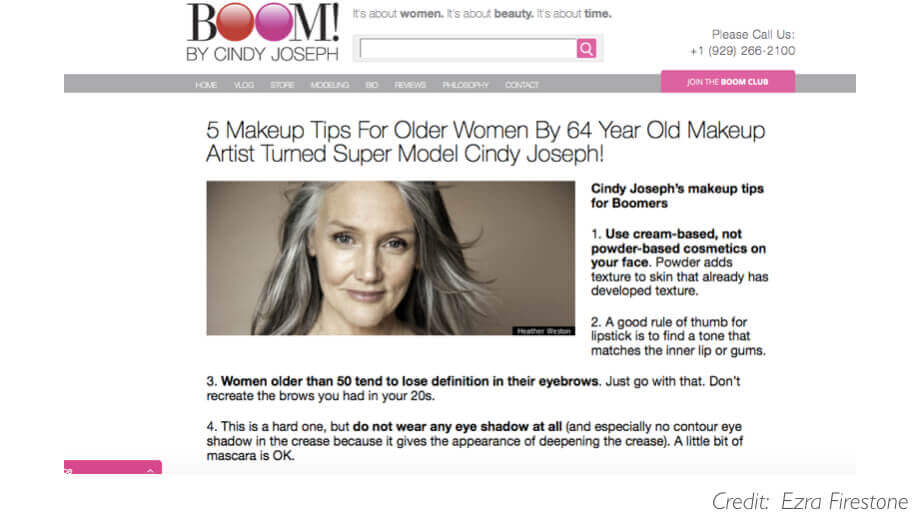
So he’s actually delivering on a promise he made in the remarketing ad, in the article. He’s giving them “The 5 Makeup Tips for Older Women by 64-Year-Old Makeup Artist Turned Supermodel Cindy Joseph.”
And then further down everything that’s in pink in this example are hyperlinks, so they are links off to other pages for the products and services:
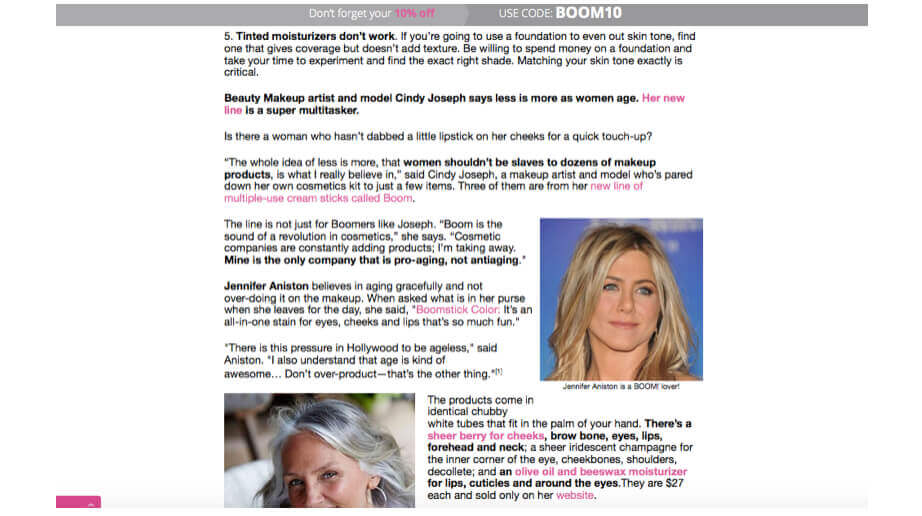
He’s got social proof in there, where he’s got celebrities that use his product. And then at the bottom of the page he actually he’s literally just pulled in his product catalog with the intent to capture those who are in the mindset of “Okay, while I’m here,” that kind of thing and it’s worked amazingly for him!
So all these things actually start to build on each other because there’s a whole bunch of people who are actively searching for your stuff, but there’s also a whole bunch of people who are not aware of it now. So what I wanted to show you is some of the ways that you can go out to much, much bigger masses and make this stuff work for your business.

